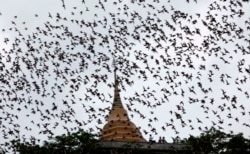Scientists studying the beginnings of the virus behind COVID-19 say a growing body of evidence argues for expanding the search beyond China into Southeast Asia.
Such research could give information about how to prevent the next pandemic.
Since the first confirmed outbreak of COVID-19 in the Chinese city of Wuhan in December 2019, researchers have been looking for the starting point of the virus in China itself.
The virus’ closest known relative shares some 96 percent of its genetic material. It is another coronavirus found early last year in the southern area of Yunnan. But some recent studies have found more viruses nearly as similar in Thailand and Cambodia. SARS-CoV-2 is the name of the virus that causes COVID-19 disease.
Looking into bats and pangolins
Scientists have already identified more than 100 SARS-related coronaviruses in bats across China, said Peter Daszak. He is a virus expert who joined the World Health Organization (WHO) trip to search for the origins of the virus in China.
He told VOA, “it may be that the origin really was in Yunnan... but my best guess is that we need to look in Myanmar, Laos, Vietnam and then even farther south.”
China has refused to provide data on some of the earliest cases of COVID-19. Even so, Daszak said, the Chinese scientists and the WHO experts agreed that SARS-CoV-2’s most likely way into humans was from bats through some sort of farmed wildlife.
Early last year scientists from China and Australia reported finding viruses matching SARS-CoV-2 by more than 90 percent in Malayan pangolins. The creatures had been illegally brought into southern China from Southeast Asia.
A few months later, scientists found viruses close to SARS-CoV-2 in horseshoe bats that had been collected in Cambodia more than ten years ago.
Then, in February, scientists in Thailand also found viruses closely matching SARS-CoV-2 in bats not far from Bangkok. They also found antibodies effective against SARS-CoV-2 in a pangolin. It was seized by local authorities in the country’s south, near Malaysia.
Search for relatives
Supaporn Wacharapluesadee, a scientist at the Chulalongkorn University in Bangkok, Thailand, took part in the recent study. She called it an “important discovery in the search for the origins of SARS-CoV-2.” She said the search for those origins should lead wherever the bats that host its closest known relatives live.
To get closer to the beginning of SARS-CoV-2, virus hunters are looking for matches even closer than the 96 percent of the kind found in Yunnan last year. The viruses found in Thailand and Cambodia were 91 percent to 93 percent similar.
Chee Wah Tan of the Duke-National University of Singapore Medical School was also on the research team. He said the search should look at the region’s bats and other virus carriers.
The viruses found in Thailand and Cambodia, “could be the ancestor or something close to the ancestor” of SARS-CoV-2, he told VOA. Daszak is not expecting any quick answers to exactly where SARS-CoV-2 began and how it jumped to humans. He said the search for the origins of the SARS virus took some five years. He added that scientists still are not sure where the Ebola virus came from more than forty years after finding it in Africa.
By following SARS-CoV-2 back to its origins, scientists hope to find other animal viruses and issues likely to cause the next pandemic and step in before they do.
Daszak compared this process to finding out information about a terrorist attack. “You don’t wait for the attack, you go out there and you disrupt that network, and you close it down. That’s what we need to do with pandemics.”
I’m John Russell.
Zsombor Peter reported on this story for VOA News. John Russell adapted it for Learning English. Hai Do was the editor.
_____________________________________________________________
Words in This Story
origin – n. the point or place where something begins or is created : the source or cause of something
match – v. to have the same appearance, color, etc.
disrupt – v. to cause (something) to be unable to continue in the normal way : to interrupt the normal progress or activity of (something)
network – n. a group of people or organizations that are closely connected and that work with each other









